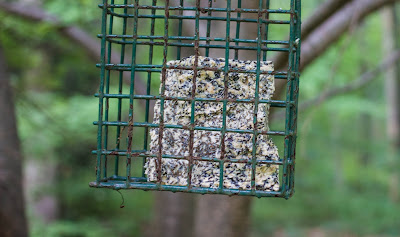Making Beef Suet Bird Feeders at Home
Making your own suet bird treats is a fun craft for the afternoon and can easily produce enough suet blocks to last a season. Starting from scratch, with real grass-fed beef suet, is the best way to ensure your feathered friends are getting a healthy and safe treat.
Rendering beef suet is easier than making lard, although the steps are pretty similar. While lard needs to be finely chopped or ground to help the rendering process, beef fat is naturally crumbly and can be separated with just your fingers or by crushing it with a rolling pin.  |
| North Woods Ranch Beef Suet |
Place the crumbled suet into a heavy bottomed pot with enough water to cover the bottom of the pot ¼ inch. The water will keep the suet from scorching in the pot.
By the time the water evaporates into steam, enough of the suet will have rendered into liquid fat, called tallow. Stir the pot occasionally to help the suet melt easily.
While the fat is rendering, choose what mix-ins you’d like to add to the suet and combine them in a large mixing bowl. Niger seeds and oatmeal have worked well for us in Central PA, but you can find Audubon and birding websites that will list a whole range of seeds, nuts, and grains that various species enjoy
When the fat turns clear, pour equal amounts of liquid fat into the mixing bowl with your chosen blend of bird seed. Stir the fat and seeds together. As the fat cools, it will turn opaque and lock the seeds into place. Pour the still warm mixture into a loaf pan, ramekin, or mold of your choosing to set the shape. Old plastic deli take-away cups produce nice round molds, while square tofu containers produce sturdy bricks. Let the mold cool overnight in the fridge.
After it cools, you can remove the suit block from the mold and put it into a suet holder (like the cage model featured) or simply tie it to a tree. The oats will absorb some of the warm fat, which will make the blocks very hard and keep them in one solid piece.
If you’ve never left suet out for birds, don’t worry if you don’t see any visitors right away. It might take a couple of days for birds to discover the suet and feel safe eating from it.
 |
| Finished Block of Bird Suet |
Recipe at a Glance:
4 lbs of North Woods Ranch Beef Suet
2 lbs of organic oats
2 lbs seeds (use the above link to find what birds in your area eat). These photos depict Niger seeds.
 |
| Save Extra Suet for Roasting Potatoes |
Crumble the fat into small pieces with your fingers or a potato masher. Put the fat into a pot with a small amount of water to prevent scorching. Bring the pot to a boil and stir often.
When the water evaporates enough of the fat should have rendered to keep the suet moist and to prevent burning. Lower the heat to medium and continue to stir occasionally, as the fat continues to render out over the next hour.
When the suet has rendered out most of its fat, pour the tallow into a large bowl with the oats and seeds. Stir to evenly distribute the seeds and oats. Pour the suet mixture into molds and allow to cool. When the mixture becomes opaque, place it in the fridge to solidify overnight.
The next day remove the molds from the fridge and turn upside down. Due to the high fat content a solid wack with your palm or a spoon should make the suet block easily drop out of the mold.
Set in your favorite birding spot and watch your feathered friends enjoy the fruits of your labor!








Comments
Post a Comment